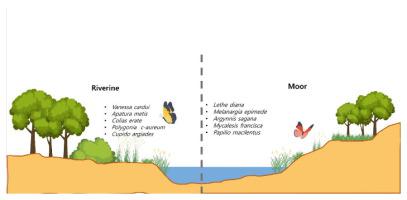Journal of Asia-Pacific Entomology ( IF 1.1 ) Pub Date : 2020-12-29 , DOI: 10.1016/j.aspen.2020.12.017 Jeong-Seop An , Sei-Woong Choi

|
Riparian ecosystems play an important role in modulating a range of ecosystem processes that affect aquatic and terrestrial organisms. Butterflies are a major herbivore in terrestrial ecosystems and are also common in riparian ecosystems. Since butterflies use plants for larval food and adult nectar sources in riparian ecosystems, butterfly diversity can be utilized to evaluate riparian ecosystems. We compiled butterfly data from 33 sites in three riparian ecosystem types across the country and compared butterfly diversity in terms of number of species and quality index in relation to riparian environmental variables. Number of butterfly and plant species was not different among three riparian habitat types. Additionally, there was no significant ecological variable to distinguish the butterfly communities on three riparian habitats. Non-metric multi-dimensional scaling ordination showed that butterfly communities in three riparian ecosystem types differed from each other, and butterfly riparian quality index was the main variable for butterfly assemblages. Five indicator species for moor and another five species for riverine riparian ecosystems were identified. Three and one indicator species for moor and riparian ecosystems, respectively, were plant specialists, while 44 butterflies were general feeders, feeding on a wide range of hostplants in several habitats. These results suggest that butterfly species use actively riparian habitats for nectar and larval food, and the butterfly riparian quality index can be employed to track faunal change in riparian habitats, which are frequently threatened by disturbances such as water level and climate changes, and invasive species.
中文翻译:

蝴蝶作为河岸生态系统评估的指标组
河岸生态系统在调节影响水生和陆地生物的一系列生态系统过程中发挥着重要作用。蝴蝶是陆地生态系统中的主要食草动物,在河岸生态系统中也很常见。由于蝴蝶在河岸生态系统中使用植物作为幼虫食物和成年花蜜来源,因此可以利用蝴蝶多样性来评估河岸生态系统。我们收集了来自全国三种河岸生态系统类型的33个站点的蝴蝶数据,并根据与河岸环境变量有关的物种数量和质量指数比较了蝴蝶多样性。三种河岸生境类型之间的蝴蝶和植物种类数量没有差异。此外,没有明显的生态变量来区分三个河岸生境中的蝴蝶群落。非度量多维标度排序表明,三种河岸生态系统类型的蝴蝶群落互不相同,并且蝴蝶河岸质量指数是蝴蝶组合的主要变量。确定了五个指标系泊物种和另外五个物种对河岸生态系统。沼泽和河岸生态系统的三个指示物种分别是植物专家,而44只蝴蝶是一般的饲养者,它们在几个生境中以各种各样的寄主植物为食。这些结果表明,蝴蝶物种活跃地利用河岸生境来获取花蜜和幼虫食物,并且可以利用蝴蝶河岸质量指数来跟踪河岸生境中的动物区系变化,而河岸生境通常受到水位和气候变化等干扰以及入侵物种的威胁。 。










































 京公网安备 11010802027423号
京公网安备 11010802027423号